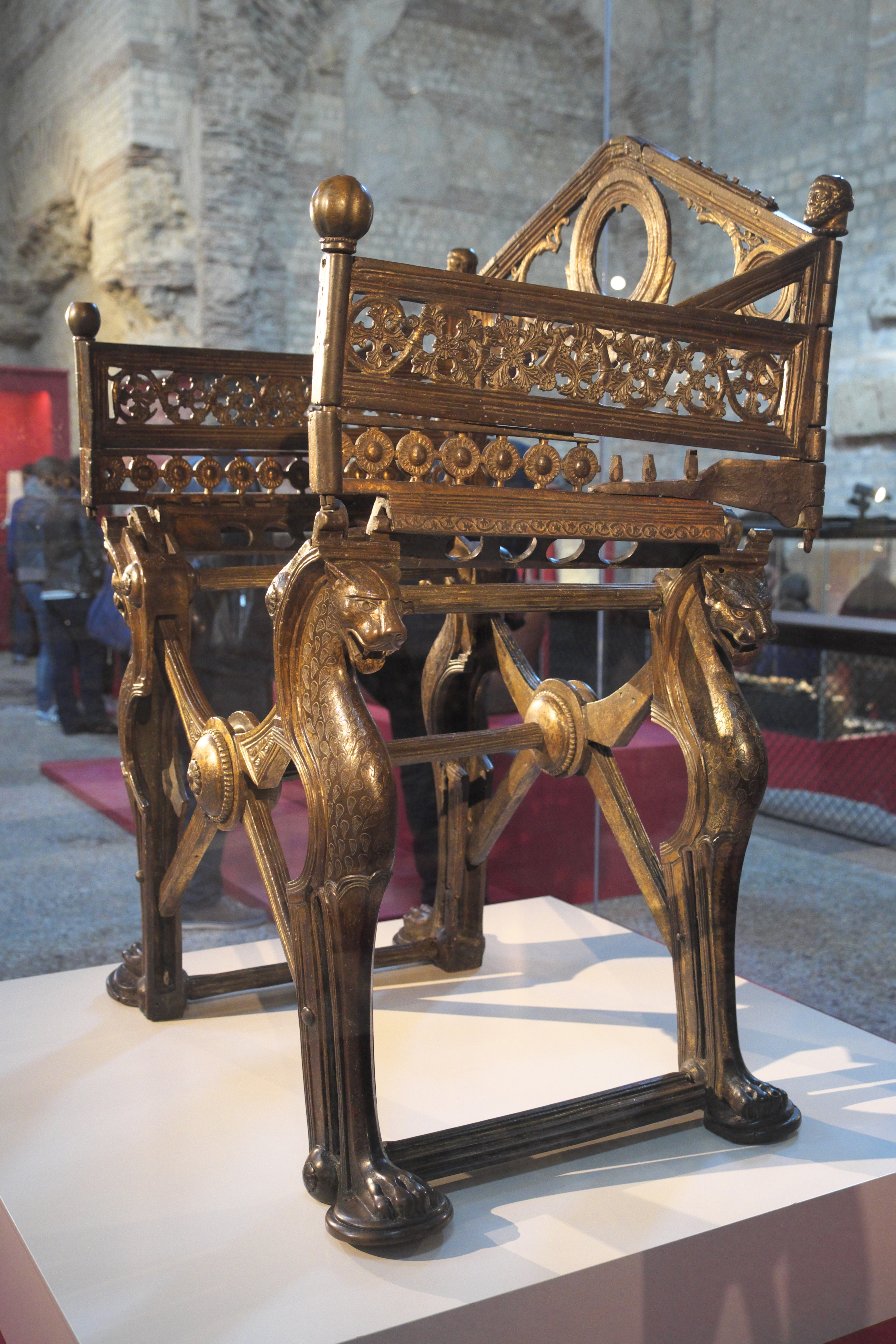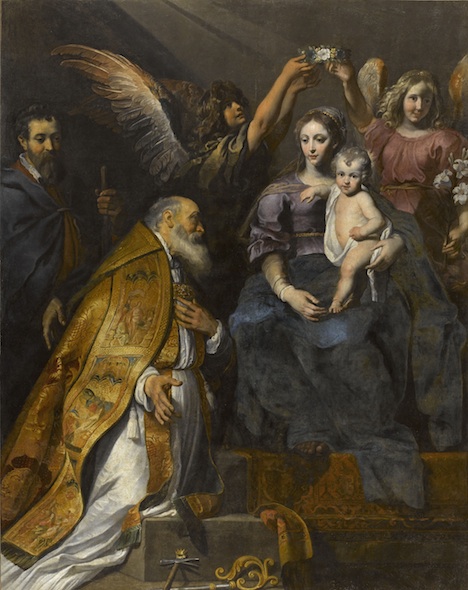|
Scepter Of Dagobert
Originally part of the French Crown Jewels, sometimes considered its oldest part, and dating from the 7th century, the scepter of Dagobert was stored in the treasure of the Basilica of Saint-Denis (also known as Basilique royale de Saint-Denis) until 1795, when it disappeared, stolen in the basilica and never seen again. Its name comes from Dagobert I (629–639), the French king for whom it was supposedly created by master goldsmith Éloi de Noyon, better known as Saint Eligius. Description Made of filigraned and enameled gold, the scepter was 56 cm long. It was made out of three parts, the rod, the hand holding the world and a statue at the top, the oldest part of the scepter.''Un autre sceptre non moins curieux est celui qui, sous le nom de Sceptre de Dagobert, fut longtemps conservé au Trésor de Saint-Denis; mais la partie supérieure seule peut être regardée comme un monument des premiers siècles de la monarchie française: elle représente un homme placé sur ... [...More Info...] [...Related Items...] OR: [Wikipedia] [Google] [Baidu] |
French Crown Jewels
The French Crown Jewels (french: Joyaux de la Couronne de France) comprise the crowns, orb, sceptres, diadems and jewels that were symbols of Royal power between 752 and 1825. These were worn by many Kings and Queens of France as well as Emperor Napoleon. The set was finally broken up, with most of it sold off in 1885 by the Third Republic. The surviving French Crown Jewels, principally a set of historic crowns, diadems and parures, are mainly on display in the ''Galerie d'Apollon'' of the Louvre, France's premier museum and former royal palace, together with the Regent Diamond, the Sancy Diamond and the ''Côte-de-Bretagne'' red spinel, carved into the form of a dragon. In addition, some gemstones and jewels (including the Emerald of Saint Louis, the Ruspoli sapphire and the diamond pins of Queen Marie Antoinette) are on display in the Treasury vault of the Mineralogy gallery in the National Museum of Natural History. Use of the French crown jewels The Crown jewels ... [...More Info...] [...Related Items...] OR: [Wikipedia] [Google] [Baidu] |
Basilica Of Saint-Denis
The Basilica of Saint-Denis (french: Basilique royale de Saint-Denis, links=no, now formally known as the ) is a large former medieval abbey church and present cathedral in the commune of Saint-Denis, a northern suburb of Paris. The building is of singular importance historically and architecturally as its choir, completed in 1144, is widely considered the first structure to employ all of the elements of Gothic architecture. The basilica became a place of pilgrimage and a necropolis containing the tombs of the Kings of France, including nearly every king from the 10th century to Louis XVIII in the 19th century. Henry IV of France came to Saint-Denis to formally renounce his Protestant faith and become a Catholic. The Queens of France were crowned at Saint-Denis, and the royal regalia, including the sword used for crowning the kings and the royal sceptre, were kept at Saint-Denis between coronations. The site originated as a Gallo-Roman cemetery in late Roman times. The arc ... [...More Info...] [...Related Items...] OR: [Wikipedia] [Google] [Baidu] |
Dagobert I
Dagobert I ( la, Dagobertus; 605/603 – 19 January 639 AD) was the king of Austrasia (623–634), king of all the Franks (629–634), and king of Neustria and Burgundy (629–639). He has been described as the last king of the Merovingian dynasty to wield any real royal power. Dagobert was the first of the Frankish kings to be buried in the royal tombs at Saint Denis Basilica. Rule in Austrasia Dagobert was the eldest son of Chlothar II and Haldetrude (575–604) and the grandson of Fredegund. Chlothar had reigned alone over all the Franks since 613. In 622, Chlothar made Dagobert king of Austrasia, almost certainly to bind the Austrasian nobility to the ruling Franks. As a child, Dagobert lived under the care of the Carolingian dynasty forebears and Austrasian magnates, Arnulf of Metz and Pepin of Landen. Chlothar attempted to manage the unstable alliances he had with other noble families throughout much of Dagobert's reign. When Chlothar granted Austrasia to Dagobert ... [...More Info...] [...Related Items...] OR: [Wikipedia] [Google] [Baidu] |
Saint Eligius
Saint Eligius (also Eloy, Eloi or Loye; french: Éloi; 11 June 588 – 1 December 660 AD) is the patron saint of goldsmiths, other metalworkers, and coin collectors. He is also the patron saint of veterinarians, the Royal Electrical and Mechanical Engineers (REME), a corps of the British Army, but he is best known for being the patron saint of horses and those who work with them. Eligius was chief counsellor to Dagobert I, Merovingian king of France. Appointed the bishop of Noyon-Tournai three years after the king's death in 642, Eligius worked for 20 years to convert the pagan population of Flanders to Christianity. Biography Eligius was born at the villa of Captelat, six miles north of Limoges, in Aquitaine (now France), into an educated and influential Gallo-Roman family. His father, recognising unusual talent in his son, sent him to the goldsmith Abbo, master of the mint at Limoges. Later Eligius went to Neustria, the palace of the Franks, where he worked under Babo, the ro ... [...More Info...] [...Related Items...] OR: [Wikipedia] [Google] [Baidu] |
List Of Missing Treasures ...
This is an incomplete list of notable treasures that are currently lost or missing. Note that the existence of some of these treasures is mythical or disputed. List See also * Art theft and looting during World War II * Looted art * Lost artworks * Lost film * Lost television broadcast * Lost literary work * Nazi gold * Nazi plunder References External links List of Lost Treasures {{Treasure Treasure Treasure Treasure Treasure (from la, thesaurus from Greek language ''thēsauros'', "treasure store") is a concentration of wealth — often originating from ancient history — that is considered lost and/or forgotten until rediscovered. Some jurisdictions leg ... [...More Info...] [...Related Items...] OR: [Wikipedia] [Google] [Baidu] |



